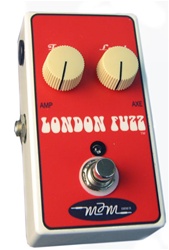One of the most elusive tones of all time is that distinguishable fuzz sound by the god himself, Jimi Hendrix. In your face, raw, exciting, and bluesy all describe this wonderful effect that Jimi got out of these pedals. I say pedals plural as his fuzzy sound can’t be attributed to just one pedal.
In the 1960s’, when fuzz pedals were introduced, germanium transistors were used giving forth a huge, warm, fuzzy sound. However, in the late 60s’, a lot of fuzz pedal makers switched over to silicon transistors which has a more aggressive and biting sound, with more gain on tap.
 If you are looking for the early Hendrix sound, aka the Monterey tone, then you would want to look into a germanium transistor based fuzz pedal. This is also the tone you would hear on his early albums. Some good pedals to replicate this sound are the Hartman Germanium Fuzz, and the MJM London Fuzz 1. There are plenty of sound clips on YouTube to hear these pedals in action.
If you are looking for the early Hendrix sound, aka the Monterey tone, then you would want to look into a germanium transistor based fuzz pedal. This is also the tone you would hear on his early albums. Some good pedals to replicate this sound are the Hartman Germanium Fuzz, and the MJM London Fuzz 1. There are plenty of sound clips on YouTube to hear these pedals in action.
Now if you want more of the later Hendrix/Band of Gypsys tone, or Isle of Wight tone, then you would want a silicon based fuzz. These pedals are typically brighter and cut through the mix better. Their added gain takes things to a new level. I personally have the Roger Mayer Axis Fuzz which is amazing for this tone. There are a lot of ways to dial in different shades of the Hendrix tone with this pedal. As well, there are great things being said about the Gypsy Fuzz by KR Musical Instruments, although this pedal can be tough to get your hands on. Randy Hansen actually exclusively uses KR pedals for his Hendrix rig.
Some tips to really nail the tone:
1) Make sure you are using a Stratocaster guitar, as Hendrix mostly used one and the single coil pickups react really well with fuzz pedals. Low output pickups work best as they were standard on Strats during Hendrix’s time.
2) Amp wise, a marshall would be preferred. Infact, best case scenario is a Marshall 100watt superlead, superbass, or JTM-45/100. But other marshall based amps will work.
3) The amp must be cranked to get the sound. Otherwise the Fuzz won’t sound great. Also when the amp is cranked, you can get controlled feedback from the fuzz as well as additional harmonic overtones that made Jimi’s tone 3 dimensional.
4) If you can’t crank it due to neighbours, then stacking it with an overdrive or preamp pedal can help. Or you can look into installing a PPI Master Volume, or attenuator.
5) Dialing in the volume and fuzz/drive on the pedal really high is something that Hendrix did a lot. To control the sound, all you have to use is your volume on your guitar. If you turn the volume down, the tone will clean up a ton. And when your guitar volume is all the way up, you will be balls-deep in fuzz, which is a great transition for solos.
6) Experience with different positions on a Wah pedal. This will add different shades to the fuzz tone, whether you want it brighter, or more bassy. I recommend the RMC Teese Picture Wah.
Anyway, I hope this info helps you are on your search for the perfect Hendrix Fuzz Tone!